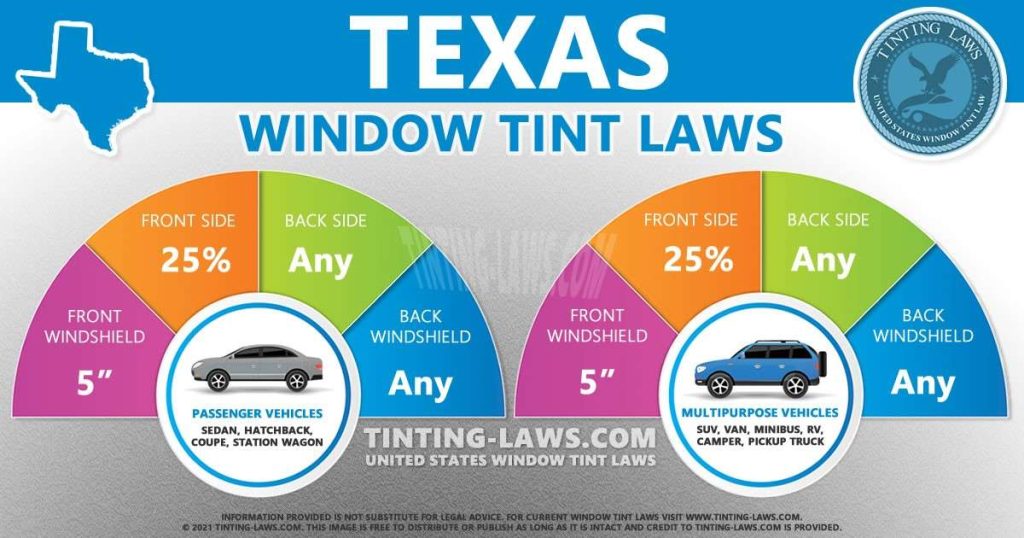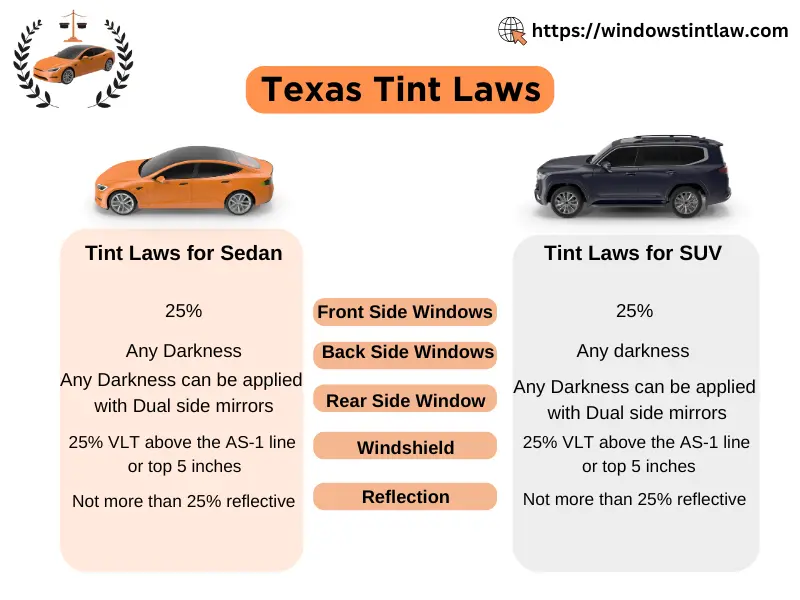Imagine cruising through the sunny streets of Texas, enjoying the comfort and privacy your tinted car windows offer. But wait, are you sure your tint complies with Texas laws?
You might be surprised to learn that not all window tints are created equal in the eyes of the law. Understanding Texas Tint Law is crucial for avoiding fines and ensuring your vehicle is street-legal. You’ll discover everything you need to know about Texas Tint Law, including the allowable tint levels and penalties for non-compliance.
We’ll guide you through the legal maze with clear, straightforward information, so you can drive with confidence and peace of mind. Whether you’re considering new tints or just want to make sure your current ones are legal, this is your go-to resource. Stay informed and keep your ride smooth and hassle-free. Let’s dive in and uncover the essentials you need to know.

Credit: www.tinting-laws.com
History Of Texas Tint Law
The history of Texas Tint Law is as colorful as the state itself. Over the years, the regulations around window tinting have evolved, reflecting changes in technology, safety concerns, and public demand. Understanding this progression not only informs your choices but also helps you stay compliant while cruising down those sunny Texan highways.
Evolution Of Tint Regulations
Window tinting wasn’t always a regulated feature. In the early days, drivers could tint their windows as dark as they wanted. This led to safety concerns, as law enforcement found it increasingly difficult to see inside vehicles during traffic stops.
Gradually, Texas introduced tint laws to balance privacy with safety. It was a move not everyone welcomed, but necessary for transparency on the road. Have you ever wondered how different your drive would be without these regulations?
Influence Of Technology
Advancements in technology have played a huge role in shaping tint laws. As tinting materials became more sophisticated, offering UV protection and glare reduction, the laws adapted. This meant that drivers could enjoy the benefits of tinting while adhering to legal standards.
With technology continuously advancing, the laws have to keep pace. How do you think future innovations might influence these regulations?
Public Demand And Legislative Change
Public opinion has always been a driver of legislative change. As more Texans sought ways to protect themselves from the intense heat, the demand for window tinting soared. Lawmakers took note, amending regulations to accommodate this growing preference.
It’s fascinating how consumer demand can shape laws. Have you ever felt the need for a darker tint during those scorching summer months?
Safety Concerns
Safety remains a top priority in the tint law history. Darker tints can obscure visibility, posing risks during nighttime driving and in emergency situations. The law aims to prevent accidents and ensure clear communication on the road.
Think about the last time you drove at night. Did your window tint affect your visibility or comfort?
Current Standards And Compliance
Today, the law is clear about what is acceptable. Texas specifies the Visible Light Transmission (VLT) percentage for different windows, ensuring drivers know the limits. Staying informed about these standards is crucial for compliance.
Are you aware of the current VLT percentages for your vehicle’s windows? Keeping up with these details ensures you’re on the right side of the law.
The history of Texas Tint Law is a testament to the balance between innovation, safety, and public demand. As you consider your tinting options, remember the journey these laws have taken and how they continue to evolve.

Credit: sunbusterstint.com
Current Regulations
With Texas’s scorching sun, tinted windows can be a lifesaver, but it’s crucial to follow the state’s tint laws. Understanding these regulations not only keeps you in compliance but can also save you from hefty fines. Let’s dive into the current regulations to see what you need to know to stay on the right side of the law.
Front Windshield Rules
The front windshield in Texas has specific rules to ensure safety and visibility. You are allowed to add a tint strip along the top of the windshield. However, this strip must not extend beyond the AS-1 line marked by the manufacturer. A clear or non-reflective tint is required below this line to meet legal standards. Have you ever been pulled over because of a tinted windshield? Ensuring your tint meets these criteria could save you from such hassles.
Front Side Windows Regulations
Front side windows have a slightly different regulation. They must allow more than 25% of light in, meaning you can’t go too dark. This ensures that law enforcement can see inside the vehicle for safety purposes. Have you checked your window tint lately? It might be worth measuring the light transmission if you’re unsure.
Back Side Windows Limitations
Back side windows have more lenient rules compared to the front. You can opt for a darker tint, as there are no specific light transmission limits. This flexibility offers more privacy and protection from the sun’s rays. However, you should still ensure the tint does not impede visibility for safe driving.
Rear Window Specifications
The rear window also benefits from relaxed regulations. Like the back side windows, there are no specific light transmission limits. However, if your rear window is tinted, Texas law requires dual side mirrors for clear rear visibility. Have you ever considered how tinted windows impact your rearview? Proper mirrors can help you maintain a clear view and stay safe on the road.
Staying informed about these regulations is essential. Not only does it keep you legal, but it also contributes to road safety. Are your windows compliant with Texas tint law? It might be time for a quick check to ensure you’re good to go.
Reasons For Tinting Restrictions
Texas imposes tinting restrictions to ensure safe driving conditions. These laws help maintain visibility for drivers and law enforcement. Limiting tint prevents accidents and allows officers to see inside vehicles for safety checks.
Tinting restrictions in Texas are shaped by a variety of reasons that aim to balance personal preferences with public safety. While tinted windows can offer numerous benefits, like privacy and UV protection, excessive tinting can lead to significant concerns. Understanding these reasons can help you appreciate why certain limitations are in place.Safety Considerations
Tinted windows can reduce glare from the sun, making it easier for you to drive comfortably. However, too dark a tint can impact your ability to see clearly, especially at night or during inclement weather. Imagine driving on a rainy night with windows so dark you can barely see the road. Safety should be a priority, and restrictions are designed to ensure you can navigate roads safely.Visibility Concerns
While you might enjoy the privacy that tinted windows provide, visibility is crucial for road safety. Dark tints can impair your view of pedestrians, cyclists, or other vehicles. Think about the last time you drove in a busy area; could you spot that cyclist immediately? Restrictions help ensure your field of vision is not compromised, protecting not just you, but everyone around you.Law Enforcement Needs
Law enforcement officers need to see inside vehicles for safety reasons during traffic stops. Excessively tinted windows can hinder this visibility, making it difficult for officers to assess situations. Consider if you were an officer approaching a car with dark windows; it might raise concerns about what’s inside. Tint laws help facilitate safer interactions between drivers and law enforcement. Do you think the benefits of tinting outweigh these concerns? Or do these restrictions make you feel more secure when on the road? Understanding both sides can guide your choices and ensure you stay compliant with local laws.Exemptions And Special Cases
Understanding the Texas Tint Law is crucial for drivers. There are specific exemptions and special cases that you should know about. These exceptions ensure that certain individuals and vehicles have the necessary flexibility while adhering to the law.
Medical Exemptions
Some individuals may qualify for medical exemptions. Texas allows darker tint for those with medical conditions. Conditions like lupus or photosensitivity might require protection from sunlight. A medical exemption requires documentation from a licensed physician. This document should clearly state the necessity for darker tint. Medical exemptions help individuals maintain their health without violating tint laws.
Commercial Vehicle Rules
Commercial vehicles follow different rules under Texas Tint Law. These vehicles often need to carry goods or passengers. Safety and visibility are key for commercial drivers. Tint regulations for commercial vehicles focus on these aspects. Commercial vehicles might have restrictions different from personal vehicles. It’s important to check specific regulations for your commercial vehicle type.
Penalties For Non-compliance
Texas Tint Law violations carry penalties that include fines and possible vehicle inspection issues. Drivers face fines for illegal tint levels, impacting compliance. Ensuring adherence to tint regulations prevents legal issues and promotes safe driving conditions.
Navigating the Texas tint law can feel like walking a tightrope. You might enjoy the privacy and sun protection that tinted windows offer, but overstepping the legal limits can lead to unwanted consequences. Understanding the penalties for non-compliance is crucial to avoid unexpected costs and maintain peace of mind on the road.Fines And Tickets
Driving with illegal tint can lead to fines and tickets that quickly add up. The first offense might be a warning, but repeated violations can cost you. In Texas, fines can range from $20 to $275 per window. Imagine getting pulled over multiple times and each time facing a hefty bill. Would it be worth the risk? Consider the impact on your driving record. Multiple fines can signal a pattern of non-compliance to law enforcement. This not only affects your wallet but also your reputation on the road. Staying within the legal limits saves you from unnecessary financial and legal troubles.Insurance Implications
Non-compliance with tint laws doesn’t just affect your wallet directly. Insurance companies might see a pattern of fines as a risk factor. This could potentially increase your premiums. Are you ready to pay more for insurance simply because of window tint? Insurance providers often assess risk based on your driving record. A record dotted with tint-related offenses could indicate to them that you are a high-risk driver. This could lead to higher rates or even difficulty in finding coverage. Keeping your tint within legal limits can help maintain favorable insurance terms. Ensuring your vehicle complies with Texas tint law saves you from penalties and keeps your record clean. It’s about making informed choices that protect your finances and driving privileges. Are you ready to take the necessary steps to comply and avoid these pitfalls?Tips For Staying Compliant
Understanding Texas tint laws can be tricky for car owners. Staying compliant ensures you avoid fines or penalties. Here are some practical tips to help you navigate the rules effectively.
Choosing The Right Tint
Selecting the appropriate tint is crucial. Each state has specific regulations. Texas law dictates the allowable darkness and reflectivity levels. Ensure your chosen tint matches these specifications. Check the visible light transmission (VLT) percentage. It must align with state requirements. Front side windows need at least 25% VLT. This ensures enough light passes through.
Working With Professionals
Professional installers understand the intricacies of tint laws. They ensure compliance with all legal standards. Professionals use quality materials that meet regulations. They offer warranties for their services. This gives peace of mind and security. Experienced installers can guide on the best tint options. They ensure your vehicle remains within legal limits.
Future Changes In Legislation
The future of Texas Tint Law is an exciting topic for car enthusiasts and legal experts alike. As technology advances and societal norms evolve, so too must the laws that govern vehicle modifications. Whether you’re a driver in Texas or just curious about where tinting laws are headed, understanding potential changes can help you prepare for what’s next.
Proposed Amendments
Lawmakers in Texas are considering several amendments to the current tint laws. These changes could redefine how much tint is permissible on car windows. In recent discussions, there has been talk of adjusting the Visible Light Transmission (VLT) percentage, which could offer more flexibility for drivers seeking privacy or protection from the sun.
Imagine driving under the scorching Texas sun, knowing your window tint provides maximum comfort. This might soon be a reality if proposed amendments pass. It’s crucial to keep an eye on these developments, as they could directly impact your driving experience and legal compliance.
Trends In Tinting Laws
Across the U.S., tint laws are becoming more lenient. States are recognizing the benefits of window tinting, such as UV protection and energy efficiency. Texas may follow this trend, making it easier for you to customize your vehicle while adhering to the law.
Take a moment to consider how these trends could affect you. Would more lenient laws make your daily commute more enjoyable? With potential changes on the horizon, now is the time to voice your opinion and engage in discussions about the future of tinting legislation.
As society’s priorities shift towards sustainability and personal comfort, tint laws are likely to reflect these values. What changes do you think would be most beneficial for drivers in Texas? Your insights could be vital in shaping future legislation.

Credit: windowstintlaw.com
Frequently Asked Questions
Is 20% Tint Legal In Texas?
20% tint is not legal for front side windows in Texas. The law requires at least 25% light transmission. Rear side windows can have any tint darkness. Check local regulations for specific details and possible exceptions. Always verify with Texas Department of Public Safety for accurate updates.
How Dark Is 25 Percent Tint?
A 25 percent tint allows 25% of light to pass through, making it moderately dark. It provides privacy and reduces glare while still allowing visibility. Ideal for those seeking a balance between style and functionality. Always check local regulations for legal limits on tint darkness.
Can I Get 5 Tint On My Car In Texas?
Texas law allows 5% tint only on back windows. Front side windows require at least 25% visibility. Check local regulations.
Will I Get Pulled Over For 15% Tint In Texas?
Yes, you might get pulled over for 15% tint in Texas. Texas law requires front side windows to allow more than 25% of light in. If your tint is too dark, it can lead to a traffic stop and possibly a fine.
Always adhere to local tint regulations.
Conclusion
Understanding Texas tint law ensures safe driving. Legal tints protect drivers. Avoid fines by following regulations. Tint laws vary by vehicle type. Always check current requirements. Regular updates help keep compliant. Safety should be a priority. Proper tint improves driving experience.
Clear vision matters on the road. Obeying laws builds trust with authorities. Protect yourself and passengers. Choose wisely when installing tint. Local professionals can guide you. Stay informed about changes. Responsible choices enhance road safety. Compliance benefits everyone. Texas laws ensure fair tint usage.
Always prioritize safety and legality. Make informed decisions about vehicle tinting.
